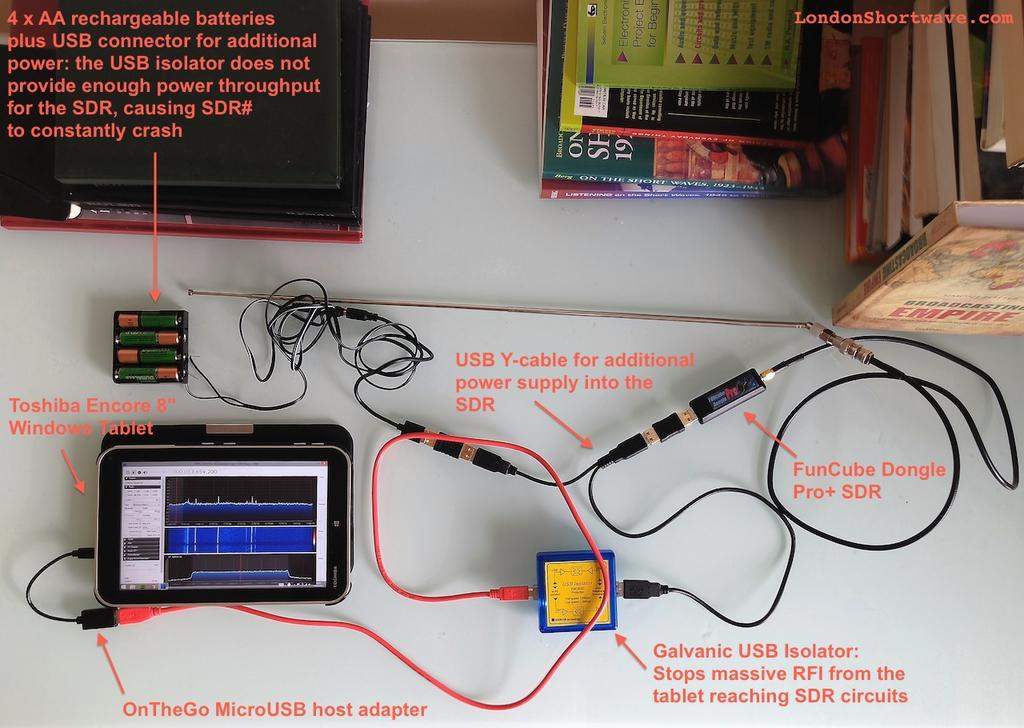SWLing Post reader, London Shortwave, is working on a portable SDR (software defined radio) system based on his Toshiba Encore 8″ Windows tablet, FunCube Dongle Pro+, and supported by the excellent SDR# application. Today, he shared this photo of his entire kit, including his comments. If you’re interested in a similar portable SDR, take note of the USB isolator and extra (AA battery) power supply.
 London Shortwave plans to make an enclosure for the SDR, AA power supply, and USB isolator.
London Shortwave plans to make an enclosure for the SDR, AA power supply, and USB isolator.
And although it may be easier said than done, it would be super if this enclosure has the same footprint as the Toshiba tablet, and the whip antenna can be mounted on the enclosure…He would then essentially have a case that he could attach to the tablet for instant portable shortwave radio fun. (Oops–did I just raise the bar for you? Ha!)
Thanks for sharing, London Shortwave!

https://www.facebook.com/photo.php?fbid=10152292977952982&set=a.72456717981.77026.717997981&type=3&theater
Already been done — no crashing, either.
The first part of my Article is ready. Hopefully the English is not too bad.
Here is the Link: http://newsroom.bonito.net/?p=845&lang=en
Have fun.
Dennis
@DL4NO thanks for the comment — when using FCD Pro+ with a PC your type of approach works very well and indeed no isolator is really necessary. There’s something in Intel Atom tablets that causes additional, massive RFI that can only be mitigated by isolating it at the USB level — you get wide (easily 40kHz) drifting noise spikes of 30dB+ and they can easily bury weak signals. I suppose it’s harder to properly ground the USB circuitry in tablet, given how slim it is, or perhaps it is a feature of the latest Intel chipset or another common tablet component.
@Dennis Walter that’s awesome- I would just love to run an SDR app on my tablet with just one cable. However, RadioJet seems to be 2.5x the price of the FCD Pro+ and the isolator combined. In any case, my primary goal here was to use components I already have to hand in my shack. Would love to give RadioJet a try one day, though!
Hello again,
of course it’s twice the price, but it is definitely a much better Receiver and a way better Software. It’s a professional “all in one solution” and that’s the reason why it’s so successful. I will exhibit at the GB Hamfest in Newark (somewhere in September) and I would be happy if we could meet over there and talking a little bit. Do you have your own Blog too?
I’ll take your word on it being a way better receiver and software combo but given the robust results I’ve been getting with SDR# and the FunCube Dongle Pro+, e.g. see here: http://wp.me/pn3uc-2Dt or here: https://swling.com/blog/2014/06/sdr-now-has-am-synchronous-detection/ or here: http://youtu.be/XMWsBuVmTvI I’d have to give them a series thorough side-by-side tests to be 100% sure! SDR# boasts a sync AM detector and passband tuning plus a solid noise reduction algorithm at the IF level. Will be happy to meet up — follow me on Twitter we’ll DM.
Dear London Shortwave, could you share where you buy that galvanic isolator?
I’m recently bought a win8 tablet similar to your and facing the same problem 🙁
Thank you!
Nice Idea, but: From day one you can use the RadioJet 1102S without extra Batteries, USB Isolator and all the wires with a Windows 8 Tablet. Only one USB-Cable is necessary and you can use all Features from the RadioJet Software without Quality limits. You can use the full 24Bit of the ADC. Many RadioJet users are using it already this way. I have showed this live at Dayton 2014. You can even use an active Antenna with our USB-Powered junction box.
You find the Image here:
Keep listening
Dennis
I think the major difference here is that the RadioJet 1102S is a $650-$784 solution, while the FunCube Dongle Pro+ is an approximately $200-$300 solution. These options are not even in the same category based upon the price of admission.
Hi Jim,
as I already had written, there is of course a price and also a big quality difference. We have already clarified the price and the quality difference, but that was not the task. The task was the portability: The RadioJet needs only one USB Cable and not all the extra hardware, cables and batteries showing on the Photo.
Also, the software package is very crucial in this case. While you have all features like free hand drawable Filters, Noise canceling, DRM, Decoders, Frequency Database, Station maps, grey line map etc. integrated in the RadioJet Software, you need to switch between 4-6 Programs with FCD on an 8” or 10” Monitor without a keyboard. This could be a big problem, when you are on the road. And think about installation: RadioJet is hassle -free and quickly installed without complicated searches for drivers and updates. Simple Plug and Play.
This discussion gaves me an Idea: I just contacted Microsoft to borrow me a Windows Surface Device. As soon as we have it here, I will write some articles and do some Videos. Because I think there will be a lot of SWLs which doesn’t even knows that they could use their Equipment with a Windows Tablet on the road and we can see how everything will be connected and installed. Therefore I already wants to thank you.
Keep listening
Dennis
I think the USB isolator is overkill. Replace it by a good common-mode yoke on the RF input and use some kind of counterpoise for the antenna. The coax cable length should be kept an a minimum as the few pF capacity of the antenna form a voltage divider with the cable capacity.